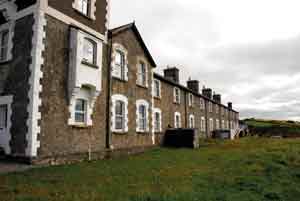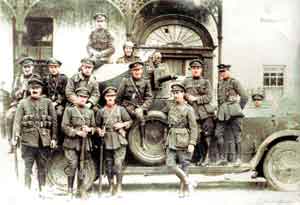THE ARRIVAL OF THE NATIONAL ARMY IN CLEW BAY, 24 JULY 1922
Published in Features, Issue 4 (July/August 2022), Volume 30By Myles Mac Evilly
That a landing of National Army troops at Westport was a possibility was considered by Tommie Heavey, formerly of the West Mayo Brigade but now in Castlebar Barracks with Michael Kilroy in July 1922 at the start of the Civil War. He stated that Michael Kilroy, who was always interested in technology, was too busy with his bomb-manufacturing endeavours there to give this much thought at the time. Bizarrely, the same thought of the landing of troops in their rear had not occurred to the anti-Treaty IRA in Dublin and elsewhere either, an indication of their lack of leadership at the time and their failure of intelligence.
In response to Emmet Dalton’s proposal to the Provisional Government’s War Council earlier in July for seaborne troops to be landed to the rear of anti-Treaty forces, Richard Mulcahy provided a list of suitable seagoing vessels to Michael Collins on 15 July 1922. As commander-in-chief of the National Army, Collins now took over the actual planning of the proposed seaborne landings, appointing men not only loyal to him but also with fighting abilities, giving command in the first instance to Col. Comdt. Christopher (‘Kit’) O’Malley from the élite Dublin Guards of the National Army to undertake the Westport landing, the first coastal landing of the Civil War.

Above: Rosmoney Coastguard Station, overlooking Moyour Channel in Clew Bay, an imposing terrace of thirteen two-storey houses, with a master’s or chief officer’s house at the end (left) and under Royal Navy control since 1856, was home to twelve Coastguard families until it was abandoned in 1916.
SS MINERVA
Having been provisioned in Dublin and taking 400 National Army soldiers on board, together with 600 rifles and 150 bicycles, and with one eighteen-pounder artillery piece and a Rolls Royce 1920-pattern armoured car on deck that weighed 4.7 tons, the SS Minerva, a former cross-channel ferry, left the North Wall in Dublin at 8pm on 22 July under the command of O’Malley and with former West Mayo Brigade officer Brigadier Joe Ring also on board. They sailed counter-clockwise around Ireland’s north coast to arrive in Clew Bay on 24 July at 2am. This was an uncomfortable journey for the 400 soldiers on board, especially on the latter part of their journey, as they sailed down the west coast against the prevailing winds.
A pilot was now requested for the approach into Westport; he arrived at 4pm, and a second pilot an hour later. Both pilots expressed the opinion that the SS Minerva was too long by 100ft to dock safely at Westport Quay, though this may well have been a disinformation ruse. Advice was sought from Portobello Barracks in Dublin but a reply was not received until the evening of the 24th—too late—ordering the operation to be aborted in favour of Limerick or Tralee, which had always been alternative destinations. In the meantime, a passing food ship, the SS Admiral, on her way to Westport, was ordered alongside and an attempt was made to offload the heavy armoured car, albeit unsuccessfully. Having missed the early morning tide, the Minerva now anchored off Lecanvey for twelve hours. Its presence was still unknown to the anti-Treaty forces on land, but not for long, as a foray on the nearby Rosmoney Coastguard Station was now planned by the National Army before the Minerva opted to continue towards Westport.

Above: Brigadier General Joseph Ring standing in front of a Rolls Royce armoured car (beneath the machine-gun) outside Westport Town Hall following the National Army landings in July 1922. (My Heritage)
ATTACK
Most likely benefiting from local intelligence, a seagoing engagement involving an assault on the Rosmoney Coastguard Station, 8km north-west of Westport, was undertaken and led by Brigadier Ring. Forty soldiers were landed from the SS Minerva onto commandeered local fishing-boats and brought to within 50m of the beach, going the rest of the way by currach. Brigadier Ring now divided his forces into two assault teams, with one making for the north side of the peninsula and the other, under his command, undertaking the southern assault. The attack began with rifle-fire from a distance of 50m, whereupon a flag of surrender was flown by the occupants, who were mostly prisoners, transferred there over the previous three weeks from Mayo and Sligo by anti-Treaty IRA, including the colourful Commandant J.C. Reynolds, formerly of the Auxiliaries and one of Michael Collins’s spies. He had been attached to the National Army’s North Western Command under Major-General Seán McKeown and was subsequently captured by the IRA. Having attempted to flee, the garrison of eleven IRA jailers was taken captive and any fires were put out, while the main force on Minerva proceeded towards Westport, where they were rapturously received by the war-weary townspeople late on 24 July 1922. Brigadier Ring and his Westport men, known as ‘Ring’s Own’, were back on home ground. The armoured car was lifted from the Minerva with the assistance of a derrick on a local dredger used for deepening the channel at Westport Quay. (Weeks later, Joseph McBride TD, one of the Westport Harbour Commissioners, wrote to Michael Collins requesting the Provisional Government formally to acknowledge the assistance given by Michael O’Grady and James Bourke, engine driver and assistant respectively of the harbour dredger.)
The next day, Tuesday 25 July, National Army forces, led by Brigadier Ring in the armoured car, made their way to Castlebar, leaving a garrison at Rosmoney and Westport. A special train containing the 79 prisoners released from Rosmoney Coastguard Station arrived in Castlebar from Westport on the following Thursday morning.
The successful Westport landing in July 1922 was described by Ó Confhaola as a template for the other National Army landings to follow—Fenit in early August and Cork soon after, with smaller attacks at Kenmare and Kinsale. They differed, however, in that the landing in Westport was unopposed.
Dr Myles Mac Evilly is a retired consultant anaesthetist and comes from Castlebar.
Further reading
D. Brunicardi, ‘The ships of the army 1922’, An Cosantóir (March 1989).
P. Ó Confhaola, ‘The naval forces of the Free State 1922–1977’ (unpublished Ph.D thesis, NUI Maynooth), Chapter 1.
P. Ó Flanagáin, ‘Brigadier General Joe Ring’, Cathair na Mart 7 (1) (1987).
E. O’Malley, The men will talk to me (ed. C. O’Malley & V. Keane) (Cork, 2014).
















